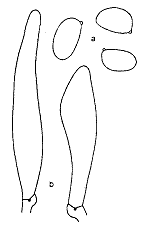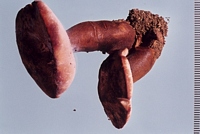|
 Gyroporus castaneus Gyroporus castaneus
SynonymsBoletus castaneus
BiostatusPresent in region - Indigenous. Non endemic
Images (click to enlarge)
Caption: FIG. 1- a, b, Gyroporus castaneus: a, spores; b, cystidia. | 
Owner: Herb. PDD |
Article: McNabb, R.F.R. (1968). The Boletaceae of New Zealand. New Zealand Journal of Botany 6(2): 137-176 (http://www.rsnz.org/publish/abstracts.php).
Description: PILEUS: convex to plano-convex, 3.5-5.5 cm diam.,
dry, finely tomentose to velutinate, cocoa brown, chestnut brown, or cinnamon
brown; cuticle composed of short-celled, filamentous hyphae 8-15 µm diam., usually
with conspicuous clamp connections and brown contents, terminal cells resembling
dermatocystidia, often projecting at right angles to surface; margin entire.
HYMENOPHORE: tubes to 7 mm long, excavated around apex of stipe, white when
young, pallid yellow at maturity; pores concolorous with tubes, subregular,
0.5-1 mm diam. STIPE: 4-5 cm long, tapering apically, occasionally subcylindrical,
1-2 cm diam., solid at first, becoming stuffed, finally hollow, dry, tomentose
to velutinate, concolorous with pileus or paler apically; flesh white to sordid
white; annulus absent.
SPORES: spore print not obtained, reported to be between
Amber Yellow and Citron Yellow; spores pallid stramineous, short-elliptical,
often ovate and flattened on one side, 7.4-11.7-(13) X 5.2-6.5-(7.2) µm., smooth.
HYMENIUM: basidia hyaline, clavate, 27-35 X 9-12 µm, 4-spored; cystidia sparse
on tube walls, crowded at tube mouths, hyaline, thin-walled, subulate with rounded
apices to ventricose-rostrate, 35-52 X 5.2-9.8 µm.. HYMENOPHORAL TRAMA: bilateral,
of the Boletus subtype; clamp connections present. CONTEXT OF PILEUS:
white to sordid white, unchanging on exposure to air. TASTE: mild. SMELL: not
distinctive. CHEMICAL REACTIONS: KOH and NH4OH on pileus and context of pileus—no
reaction.
Habitat: HABITAT: Solitary, gregarious, or caespitose under Leptospermum.
Notes: Gyroporus castaneus
is widely distributed throughout temperate regions of the northern hemisphere,
where it occurs in association with both coniferous and broad leaved trees.
The fact that both the above collections were found in relatively undisturbed
native forest suggests that it is indigenous to New Zealand. Singer (1945b)
noted an unconfirmed report of its occurrence in Australia, but did not state
whether it was indigenous or introduced. G. castaneus is reported to be an edible
fungus by European mycologists.
The species is readily recognisable by the chestnut
brown fruit bodies, hollow stipe, pallid stramineous spores, and presence of
clamp connections. It has not previously been recorded from New Zealand.
|